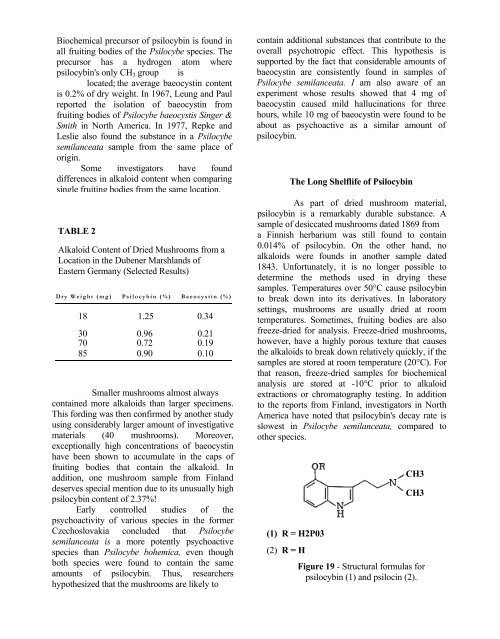Jochen Gartz - Magic Mushrooms Around the ... - preterhuman.net
Jochen Gartz - Magic Mushrooms Around the ... - preterhuman.net
Jochen Gartz - Magic Mushrooms Around the ... - preterhuman.net
Create successful ePaper yourself
Turn your PDF publications into a flip-book with our unique Google optimized e-Paper software.
Biochemical precursor of psilocybin is found in<br />
all fruiting bodies of <strong>the</strong> Psilocybe species. The<br />
precursor has a hydrogen atom where<br />
psilocybin's only CH 3 group is<br />
located; <strong>the</strong> average baeocystin content<br />
is 0.2% of dry weight. In 1967, Leung and Paul<br />
reported <strong>the</strong> isolation of baeocystin from<br />
fruiting bodies of Psilocybe baeocystis Singer &<br />
Smith in North America. In 1977, Repke and<br />
Leslie also found <strong>the</strong> substance in a Psilocybe<br />
semilanceata sample from <strong>the</strong> same place of<br />
origin.<br />
Some investigators have found<br />
differences in alkaloid content when comparing<br />
single fruiting bodies from <strong>the</strong> same location.<br />
TABLE 2<br />
Alkaloid Content of Dried <strong>Mushrooms</strong> from a<br />
Location in <strong>the</strong> Dubener Marshlands of<br />
Eastern Germany (Selected Results)<br />
Dry Weight (mg) Psilocybin (%) Baeocystin (%)<br />
18 1.25 0.34<br />
30 0.96 0.21<br />
70 0.72 0.19<br />
85 0.90 0.10<br />
Smaller mushrooms almost always<br />
contained more alkaloids than larger specimens.<br />
This fording was <strong>the</strong>n confirmed by ano<strong>the</strong>r study<br />
using considerably larger amount of investigative<br />
materials (40 mushrooms). Moreover,<br />
exceptionally high concentrations of baeocystin<br />
have been shown to accumulate in <strong>the</strong> caps of<br />
fruiting bodies that contain <strong>the</strong> alkaloid. In<br />
addition, one mushroom sample from Finland<br />
deserves special mention due to its unusually high<br />
psilocybin content of 2.37%!<br />
Early controlled studies of <strong>the</strong><br />
psychoactivity of various species in <strong>the</strong> former<br />
Czechoslovakia concluded that Psilocybe<br />
semilanceata is a more potently psychoactive<br />
species than Psilocybe bohemica, even though<br />
both species were found to contain <strong>the</strong> same<br />
amounts of psilocybin. Thus, researchers<br />
hypo<strong>the</strong>sized that <strong>the</strong> mushrooms are likely to<br />
contain additional substances that contribute to <strong>the</strong><br />
overall psychotropic effect. This hypo<strong>the</strong>sis is<br />
supported by <strong>the</strong> fact that considerable amounts of<br />
baeocystin are consistently found in samples of<br />
Psilocybe semilanceata. I am also aware of an<br />
experiment whose results showed that 4 mg of<br />
baeocystin caused mild hallucinations for three<br />
hours, while 10 mg of baeocystin were found to be<br />
about as psychoactive as a similar amount of<br />
psilocybin.<br />
The Long Shelflife of Psilocybin<br />
As part of dried mushroom material,<br />
psilocybin is a remarkably durable substance. A<br />
sample of desiccated mushrooms dated 1869 from<br />
a Finnish herbarium was still found to contain<br />
0.014% of psilocybin. On <strong>the</strong> o<strong>the</strong>r hand, no<br />
alkaloids were founds in ano<strong>the</strong>r sample dated<br />
1843. Unfortunately, it is no longer possible to<br />
determine <strong>the</strong> methods used in drying <strong>the</strong>se<br />
samples. Temperatures over 50°C cause psilocybin<br />
to break down into its derivatives. In laboratory<br />
settings, mushrooms are usually dried at room<br />
temperatures. Sometimes, fruiting bodies are also<br />
freeze-dried for analysis. Freeze-dried mushrooms,<br />
however, have a highly porous texture that causes<br />
<strong>the</strong> alkaloids to break down relatively quickly, if <strong>the</strong><br />
samples are stored at room temperature (20°C). For<br />
that reason, freeze-dried samples for biochemical<br />
analysis are stored at -10°C prior to alkaloid<br />
extractions or chromatography testing. In addition<br />
to <strong>the</strong> reports from Finland, investigators in North<br />
America have noted that psilocybin's decay rate is<br />
slowest in Psilocybe semilanceata, compared to<br />
o<strong>the</strong>r species.<br />
(1) R = H2P03<br />
(2) R = H<br />
CH3<br />
CH3<br />
Figure 19 - Structural formulas for<br />
psilocybin (1) and psilocin (2).








![The Big Lie 9-11 and Government Complicity in Mass Murder [PDF]](https://img.yumpu.com/50957077/1/190x245/the-big-lie-9-11-and-government-complicity-in-mass-murder-pdf.jpg?quality=85)








